Spots on cactus are a big problem among cactus lovers. There are various kinds of spots and various reasons for those spots.
Spots on cactus can occur due to animal attack, fungal disease, frost bite, or chemicals. Although this condition is not fatal, it can be aesthetically damaging. For example, if your cacti have white spots, that may be due to a mealybug attack. Those white spots would be more like the protective shields of the mealybugs and of the scales. In addition to that, fungus growths may also result in white spots on your cactus. It is critical that you treat those spots as soon as you notice them so that you can overcome them from the beginning. Unless it would lead to yellowing, abnormal foliage, etc.
Now you understand the importance of knowing about spots on cactus. Therefore, I thought of writing this article about the spots that your cactus may come across and the methods that you could use to overcome them.
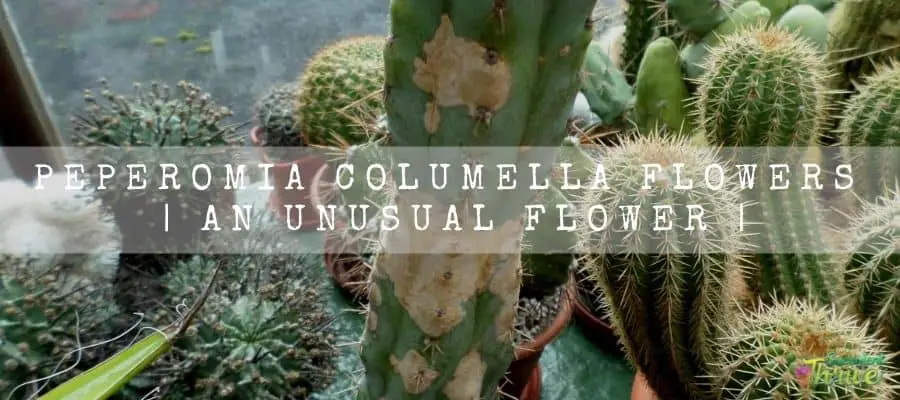
There are several factors which could result in spots in your cactus. It could be mainly due to pest infestations.
White spots on cactus and treatments
Pests
If we consider the indoor cactus, they tend to get infected with cochineal insects’ diseases.
For example, mealybugs and scales would be quite attractive towards them. One might think of the soft cottony white fuzz as mold whereas it is not.
If we consider the scales, you could spot them in brown, and they would be covered with white fluff. Scales would usually feed on the cactus sap. Consequently, it would make the cactus dry and cause yellow or white spots.
If I elaborate on mealybugs, they are small creatures. They are not the fast movers and instead tend to move slowly.
In terms of the sizes, they would be 1/20 to 1/5 inch ( 0.13 – 0.5 cm). They would also fulfill their dietary requirements from underneath their white fuzz.
To elaborate further on this, we will learn about the growth cycle of the mealybugs first. Mealybug’s life span would usually be about ten weeks’ time.
It would usually take about one or two weeks for the eggs to develop into nymphs. After about six weeks’ time, the nymphs would transform into the mature stage of the mealybugs.
These are fast spreaders particularly due to the aforesaid short life cycle. They can go unnoticed in the smallest areas in your cactus, and they can keep feeding on your cactus while multiplying.
Once the cactus is infected by the mealybugs , you could see their twisted foliage and yellowed leaves.
These pest infestations could be so worse as they would go unnoticed at the initial stage, and you can identify them only once they cause greater damage to the plants. Mealybugs are not picky. Hence, they can end up landing on any other plant and start spreading.
Treatments
To treat them, you can spray the healthy plants with neem so that it will avoid the mealybugs landing up on the healthy plants. It would act like a repellent.
In case the mealybug infestation is on a severe level, you need to consider repotting the plants. If they spread on a minor level, you can simply destroy them by manually or by using tweezers.
In addition to that you may practise the following to get rid of them
You may also use Isopropyl alcohol also to treat the cactus. You simply have to dip them in the alcohol and apply them on the bugs there. It is somewhat time consuming , but it could be very effective in destroying the insects.
Ensure that you closely check the hidden areas such as the base of the plants, underneath the leaves and the leaf joints etc.
Further chances are that the mealybugs can live in the substrate as well. Hence it would be better if you could remove the top layer of the soil and check whether there are any bugs hiding there.
If you spot any white fuzz on the roots, you need to cleanse them using lukewarm water.
After that, dip them in pesticides. Next, wither them and repot them as well. If you use alcohol you need to keep doing it daily for about one week.
That will kill all the bugs. If you do it on and off, it is very unlikely that you will get rid of them. instead, they would multiply.
Having said that you need to first have a small amount of isopropyl and refrain from applying a plenty of alcohol on the plants.
You may also use a DIY insecticide to treat them and it is rather a quick way of overcoming these. Having said that you need to be cautious when using them as chances are that it may harm your precious cactus.
To make the insecticide, you can mix 1 teaspoon of liquid into one liter of water. Next bring the plants to a sink and wash the affected areas with the insecticide.
Next, use cold fresh water and wash them well. Never leave water on the plants and instead ensure that you wither them and then shift them to a safer place.
Continue doing this activity for a couple of days and keep inspecting your plants to spot if there are any remaining bugs.
Chances are that there could be still one or two bugs despite what you do to overcome them. If the bug infestation is in a severe place, a combination of neem oil , alcohol and an insecticidal soap would help.
Furthermore, keep in mind to wash your tools after you interact with infected plants. And, you may also use predators such as ladybugs, lacewings etc. to treat these bugs.
Fungus
Besides the bug attack, fungus could also result in white spots on the cactus. If you expose them to humid conditions, it will make the plants more prone towards the fungal attacks.
Furthermore, the area under the fungus would be soft. White spots could pave the way for stunt growths, yellowing and in deforming the foliage as well. Further chances are that it could be due to powdery mildew as well.
Treatments
First you need to remove the infected areas. To treat them, you can use a solution of 01 parts of milk along with 3 parts of water and spray them on the affected areas. You may simply use a spray bottle and repeat applying them for two to three days.
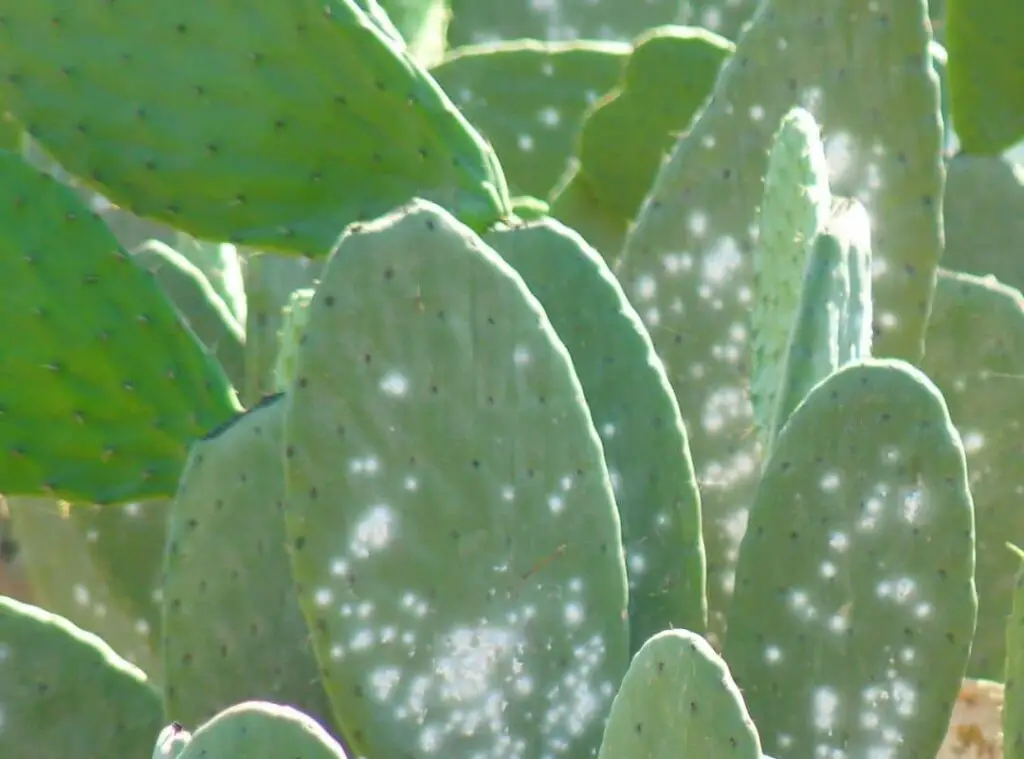
Rust spots on cactus and treatments
Rust Fungus
Puccinia fungus species is what causes the rust fungus. You could identify them as light brown patches along with orange recessed areas specially on the cactus epidermis.
Your precious cactus may suffer from these fungi growths If you expose the plants to warmer temperatures in a moist environment. If there is a poor aeration , it would be even more attractive for these fungi.
It is important that rust fungus get specific conditions so that they can keep infecting and spreading on the plants. the fungal spores would stay enclosed to the moist cactus.
The germination of them will take place during these settings. Moreover, if there is an acidic soil condition it would hasten the growth of the spores.
Chances are that these fungal spores can spread to your cactus through wind and that is when they start contaminating your plants. Besides wind, this rust fungus can spread through mealybugs and through aphids as well.
Furthermore, the established spores could further disperse during watering . Moreover, it could take place when you try to touch the plants with contaminated hands as well.
Further contaminated instruments may also speed these. This is a fungus which could be contagious, and it could be worse if you do not attend to it soon.
Red Spider Mites
Once the red spider mites infect the cactus, you could spot their stems carrying tiny orange spots.
They would puncture the epidermis and will be feeding on the plant juice. They would usually live in dry and warmer environments.
When the red spider mites keep spreading, you could spot the red orange blotches more as they would be more visible.
You cannot spot these creatures with your naked eyes, and one might think that it could be a fungal attack by simply looking at it.
However, when you look at them closer, you will see how the red spider mites move. If you could spot a messy web around the cactus stem along with white strands, it could be most probably due to the red spider mite’s attack.
Fungal Scab
Fungal scab is a superficial rusty patch which could form on the cactus skin.
There will be fungal spores forming below the waxy epidermis and it would give a rust color to this fungus. Their texture would tend to look like a hardened flat bump which you can peel off.
The initial stage of the scab is sort of like edema as the cactus cells would enlarge due to excess moisture and due to the poor ventilation.
When the cells fill with too much water , it would create a microscopic opening on the stem which would be quite useful for the fungal spores.
When they keep spreading, they would infect the cells which are in the surrounding area and would result in patches of scabs. Edema is not contagious, but the orange spores can infect the rest of other plants.
Treatments
You cannot get rid of the rust spots unless you cut them off. However, you can control them unless you cut the damaged sections.
However, to control and prevent them, you may use DIY remedies. For example, you may use neem oil solutions, sodium bicarbonate and fungicides which contain sulfur and copper etc.
To further elaborate on these, you can trim off the infected areas while using sterile cutting tools for that purpose.
Once you cut them off, you need to discard them properly as well. After that you need to peel off the fungal scabs while using a disinfected knife.
You may apply cinnamon or sulfur powder also on the wounds so that it will inhibit the pathogens.
Chances are that it could leave scars on the cactus when you trim them off. However, it would help the plants to grow new growths of the plants and avoid spreading the spores.
Moreover you need to sanitize the surroundings so that it will avoid these rust reoccurring. If there is a severe infestation, you need to get rid of the cactus.
Besides the above, you may use a neem oil solution also to treat the rust spots. Simply you have to mix 2 tablespoons of cold pressed concentrated neem oil into one gallon of water and stir it well. That will ensure the solution is homogeneous.
You can simply apply the solution by spraying it on the affected area and on the soil as well. further neem oil halt the adult mites in laying eggs and make them infertile as well.
Neem oil is not something which could have a fatal impact on the spider mites. However, it would stop them developing them though.
You may also use organic fungicides also to control the rust. However, you can practice this only if you find it difficult to overcome the rust from the aforesaid methods.
You can use fungicides which include sulfur, copper and permethrin etc. as they would be more effective in treating these.
You may apply liquid or dust fungicides which include sulfur to remedy these. For example, you can consider using powder sulfur to treat the fungal scabs.
You can simply dust off the infected areas with sulfur powder. Once the fungal spores get in contact and ingest it would kill them. Besides, sulfur would act as a repellent to mites as they contain a strong odor.
If you wish to overcome the fungal rust, you can consider using fungicides which contain copper. You can easily find them in ready to use spray bottles. However, i recommend you to wear all protective gear before you apply these
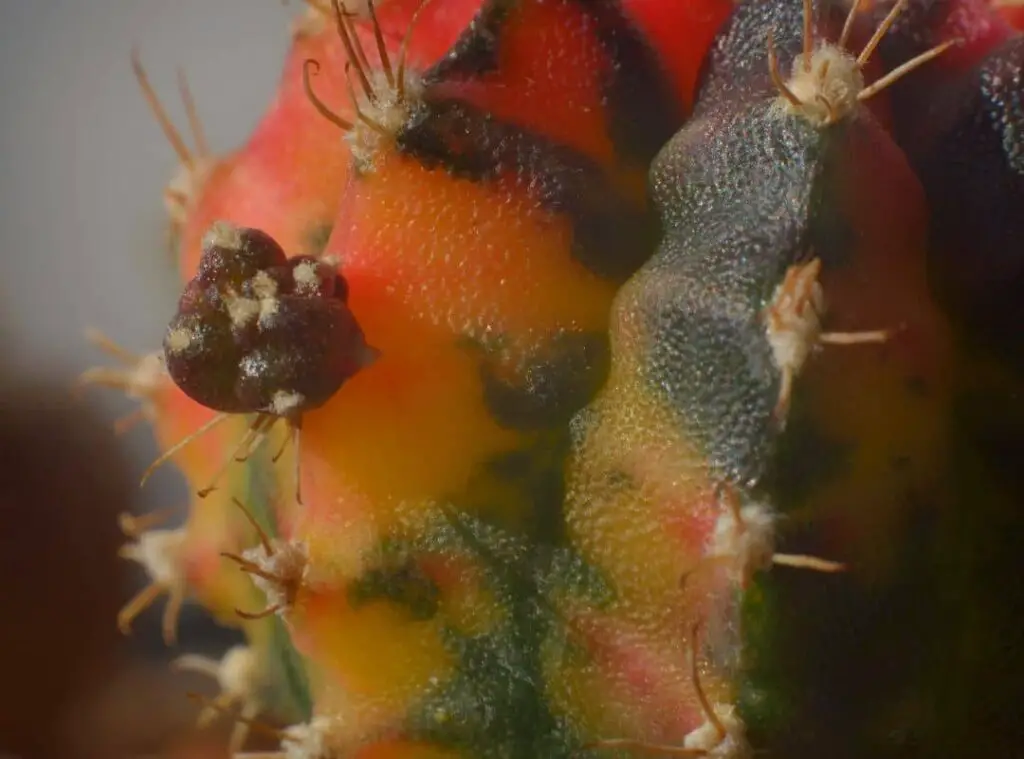
Black spot-on cactus and treatments
Soft rot
The bacteria of Erwin genus are what cause the soft rot in the cactus. They would literally enter the damaged cactus tissues and would contribute to root rot as well as for the crown rot in agave plants.
Moreover, it would result in the bacterial necrosis in saguaros plants. Whenever there are high humidity levels, they would tend to enter the plants and multiply rapidly.
Once these bacteria invade, you could spot either black pots or the brown posts forming. It would further crack the and leak the fluid of the cactus also.
To control them, you need to cut the plant sections with the black spots under 2 inches.
Further you need to take out a healthy tissue layer of ¼ – ½ inches wide around the wound and allow it to wither afterwards.
If you could spot liquid exuding from the wound, it is useless to treat them. However, you can avoid the future problems happening by treating open wounds with a fungicide which contains copper whilst keeping a low humidity around the plants.
Dry rot
Fungi such as Phyllosticta concave and Mycosphaerella are what cause the dry rot.
You could see the small black circular spots developing on the cactus once they suffer from dry rot. You could commonly spot this condition among the prickly pear pads along brown rims.
If there is a cactus which is severely affected with this condition it is highly unlikely that you could cure it.
Hence, in that circumstance best would be to destroy them. if the dry rot is a minor level, you can simply remove the affected sections and discard them. Ensure that you water them sparingly also.
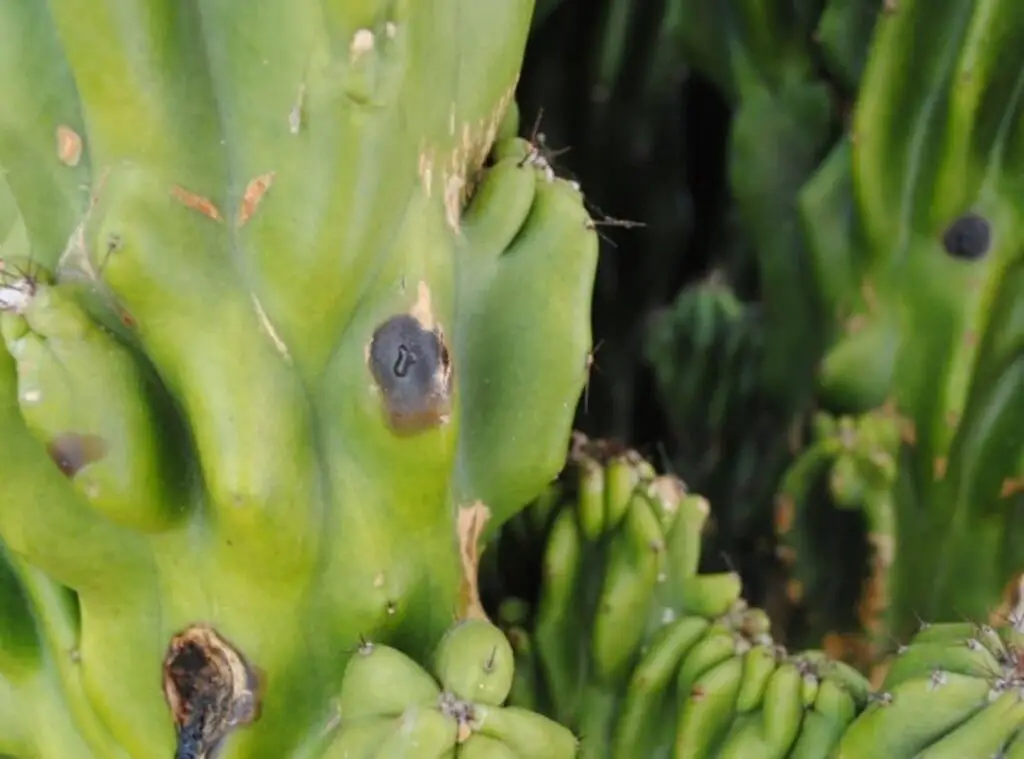
Brown spots on cactus and treatments
Excess sunlight on young pants, damages from animals and frost are what could cause the brown spots on the cactus.
Moreover, certain pesticides and certain diseases could also affect this condition. One might think these brown spots are a fungal lesion which you could spot when a cactus has humid weather conditions in winter.
However brown spots do not ever result in the death of the plants. But it would make the plants aesthetically less attractive.
Literally you cannot get rid of those spots, and they would remain as scars. As such ensure that you always practice the right growing practices whilst not exposing them to excess sunlight so that your precious cactus do not have g through this condition.
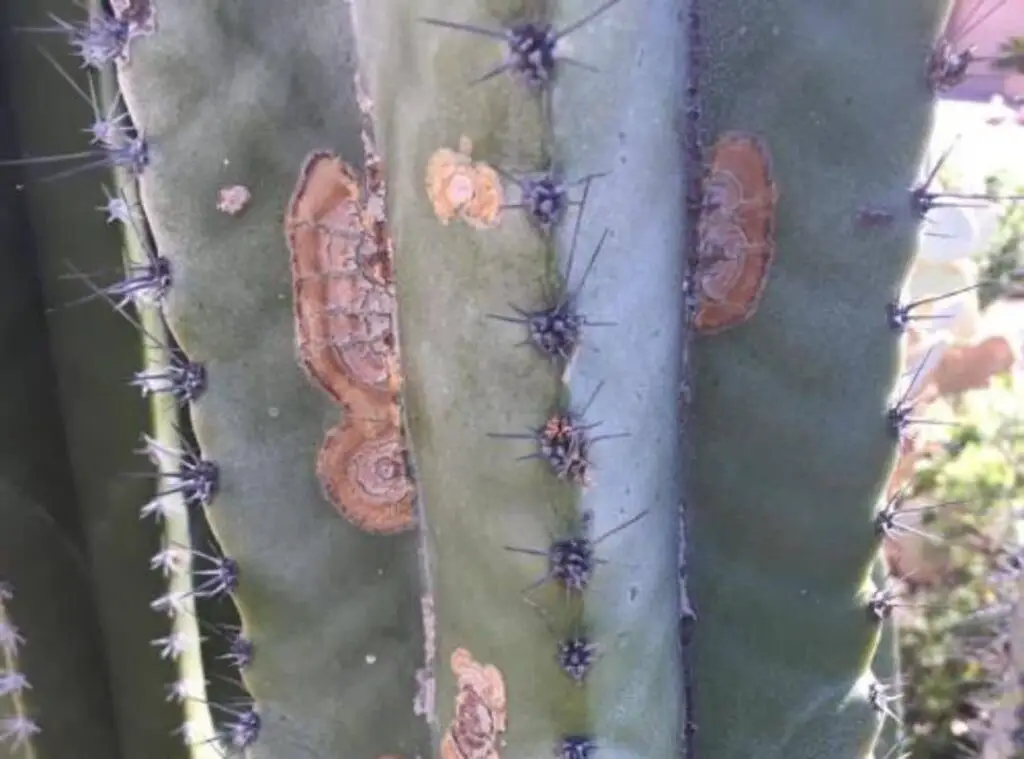
Yellow spots on cactus and treatments
There are few reasons which affect the yellow spots of the cactus. It could be mainly due to nutrient deficiency of the cactus.
Additionally, it may also be a symptom of a bacterial and a fungal infection.
Further overwatering, less sun exposure may also pave the way for yellow spots on the cactus.
If you figure out the yellow spots are due to nutrients deficiency you may consider applying fertilizers.Ensure that you provide a soil mix which is in high porosity for their proper growth.
Ensure that you use soil mediums which have additional nutrients such as iron, calcium etc. so that the growth of the plants would be benefited.
If there are yellow spots due to overwatering, you need to cut back on watering the plants and allow the soil to wither between two watering sessions. Ensure that there is no water retained in the pots.
The lack of sunlight exposure may result in the yellow spots of your precious cactus. In that case, increase the sunlight exposure.
If you have placed them indoors, you can place grow lights closer to them. On the other hand, excessive sunlight exposure may also lead to yellow spots of the cactus.
Under watering during drought conditions is one more factor which could cause yellow spots of the plants. As such to remedy that, you need to resume watering them.
Moreover the drastic changes in temperature will also contribute to yellow spots. To avoid that happening, ensure that you slowly expose them to these conditions.
How to get rid of spots on cactus in general
- You may consider using fungicides to treat them.
- Snip off the damaged plant sections while ensuring that there is no damage done to the plants
- Ensure that you always water the plants well. Never over water them.
- Provide a good aeration and a sterile potting medium
- Ensure that you conduct inspections once every two to three months
- Always quenartinite the newly purchased purchased plants from others for a short while
Read Next : Important Epiphyllum Diseases | 07 Major Issues You Might Face |
